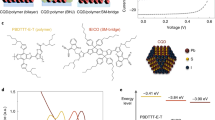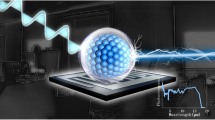Abstract
Colloidal quantum dot (CQD) light-emitting diodes (LEDs) deliver a compelling performance in the visible, yet infrared CQD LEDs underperform their visible-emitting counterparts, largely due to their low photoluminescence quantum efficiency. Here we employ a ternary blend of CQD thin film that comprises a binary host matrix that serves to electronically passivate as well as to cater for an efficient and balanced carrier supply to the emitting quantum dot species. In doing so, we report infrared PbS CQD LEDs with an external quantum efficiency of ~7.9% and a power conversion efficiency of ~9.3%, thanks to their very low density of trap states, on the order of 1014 cm−3, and very high photoluminescence quantum efficiency in electrically conductive quantum dot solids of more than 60%. When these blend devices operate as solar cells they deliver an open circuit voltage that approaches their radiative limit thanks to the synergistic effect of the reduced trap-state density and the density of state modification in the nanocomposite.
This is a preview of subscription content, access via your institution
Access options
Access Nature and 54 other Nature Portfolio journals
Get Nature+, our best-value online-access subscription
$29.99 / 30 days
cancel any time
Subscribe to this journal
Receive 12 print issues and online access
$259.00 per year
only $21.58 per issue
Buy this article
- Purchase on Springer Link
- Instant access to full article PDF
Prices may be subject to local taxes which are calculated during checkout




Similar content being viewed by others
Data availability
The data that support the plots within this paper and other findings of this study are available from the corresponding author upon reasonable request.
References
Borek, C. et al. Highly efficient, near-infrared electro phosphorescence from a Pt–metalloporphyrin complex. Angew. Chem. 46, 1109–1112 (2007).
Goossens, S. et al. Broadband image sensor array based on graphene–CMOS integration. Nat. Photonics 11, 366–371 (2017).
Murphy, C. J. Optical sensing with quantum dots. Anal. Chem. 74, 520A–526A (2002).
Medintz, I. L., Uyeda, H. T., Goldman, E. R. & Mattoussi, H. Quantum dot bioconjugates for imaging, labelling and sensing. Nat. Mater. 4, 435–446 (2005).
Voura, E. B., Jaiswal, J. K., Mattoussi, H. & Simon, S. M. Tracking early metastatic progression with quantum dots and emission scanning microscopy. Nat. Med. 10, 993–998 (2004).
Park, S. I. et al. Soft, stretchable, fully implantable miniaturized optoelectronic systems for wireless optogenetics. Nat. Biotechnol. 33, 1280–1286 (2015).
Kim, J. et al. Battery-free, stretchable optoelectronic systems for wireless optical characterization of the skin. Sci. Adv. 2, e1600418 (2016).
Lopez, A., Arazuri, S., García, I., Mangado, J. & Jaren, C. A review of the application of near-infrared spectroscopy for the analysis of potatoes. J. Agric. Food. Chem. 61, 5413–5424 (2013).
Shirasaki, Y., Supran, G. J., Bawendi, M. G. & Bulović, V. Emergence of colloidal quantum-dot light-emitting technologies. Nat. Photonics 7, 13–23 (2013).
Pal, B. N. et al. ‘Giant’ CdSe/CdS core/shell nanocrystal quantum dots as efficient electroluminescent materials: strong influence of shell thickness on light-emitting diode performance. Nano Lett. 12, 331–336 (2012).
Mashford, B. S. et al. High-efficiency quantum-dot light-emitting devices with enhanced charge injection. Nat. Photonics 7, 407–412 (2013).
Dai, X. et al. Solution-processed, high-performance light-emitting diodes based on quantum dots. Nature 515, 96–99 (2014).
Hines, M. A. & Scholes, G. D. Colloidal PbS nanocrystals with size‐tunable near‐infrared emission: observation of post‐synthesis self‐narrowing of the particle size distribution. Adv. Mater. 15, 1844–1849 (2003).
Supran, G. J. et al. High-performance shortwave-infrared light-emitting devices using core–shell (PbS–CdS) colloidal quantum dots. Adv. Mater. 27, 1437–1442 (2015).
Yang, X. et al. Iodide capped PbS/CdS core-shell quantum dots for efficient long wavelength near-infrared light-emitting diodes. Sci. Rep. 7, 14741 (2017).
Sun, L. et al. Bright infrared quantum-dot light-emitting diodes through inter-dot spacing control. Nat. Nanotech. 7, 369–373 (2012).
Yang, Z. et al. All-quantum-dot infrared light-emitting diodes. ACS Nano 9, 12327–12333 (2015).
Gong, X. et al. Highly efficient quantum dot near-infrared light-emitting diodes. Nat. Photonics 10, 253–257 (2016).
Bourdakos, K. N., Dissanayake, D. M. N. M., Lutz, T., Silva, S. R. P. & Curry, R. J. Highly efficient near-infrared hybrid organic-inorganic nanocrystal electroluminescence device. Appl. Phys. Lett. 92, 153311 (2008).
Colvin, V. L., Schlamp, M. C. & Alivisatos, A. P. Light-emitting diodes made from cadmium selenide nanocrystals and a semiconducting polymer. Nature 370, 354–357 (1994).
Tessler, N., Medvedev, V., Kazes, M., Kan, S. & Banin, U. Efficient near-infrared polymer nanocrystal light-emitting diodes. Science 295, 1506–1508 (2002).
Konstantatos, G., Huang, C., Levina, L., Lu, Z. & Sargent, E. H. Efficient infrared electroluminescent devices using solution-processed colloidal quantum dots. Adv. Func. Mater. 15, 1865–1869 (2005).
Roy Choudhury, K., Song, D. W. & So, F. Efficient solution-processed hybrid polymer–nanocrystal near infrared light-emitting devices. Org. Electron. 11, 23–28 (2010).
Rath, A. K. et al. Remote trap passivation in colloidal quantum dot bulk nano‐heterojunctions and its effect in solution‐processed solar cells. Adv. Mater. 26, 4741–4747 (2014).
Pradhan, S., Stavrinadis, A., Gupta, S., Christodoulou, S. & Konstantatos, G. Breaking the open-circuit voltage deficit floor in pbs quantum dot solar cells through synergistic ligand and architecture engineering. ACS Energy Lett. 2, 1444–1449 (2017).
Carey, G. H., Levina, L., Comin, R., Voznyy, O. & Sargent, E. H. Record charge carrier diffusion length in colloidal quantum dot solids via mutual dot‐to‐dot surface passivation. Adv. Mater. 27, 3325–3330 (2015).
Zhitomirsky, D. et al. Engineering colloidal quantum dot solids within and beyond the mobility-invariant regime. Nat. Commun. 5, 3803 (2014).
Bi, Y. et al. Infrared solution‐processed quantum dot solar cells reaching external quantum efficiency of 80% at 1.35 µm and J SC in excess of 34 mA cm–2. Adv. Mater. 30, 1704928 (2018).
Pradhan, S. et al. Trap‐state suppression and improved charge transport in PbS quantum dot solar cells with synergistic mixed‐ligand treatments. Small 13, 1700598 (2017).
Bi, Y. et al. Colloidal quantum dot tandem solar cells using chemical vapor deposited graphene as an atomically thin intermediate recombination layer. ACS Energy Lett. 3, 1753–1759 (2018).
Qian, L. et al. Electroluminescence from light-emitting polymer/ZnO nanoparticle heterojunctions at sub-bandgap voltages. Nano Today 5, 384–389 (2010).
Ji, W. et al. The work mechanism and sub-bandgap-voltage electroluminescence in inverted quantum dot light-emitting diodes. Sci. Rep. 4, 6974 (2014).
Li, J. et al. Single-layer halide perovskite light-emitting diodes with sub-band gap turn-on voltage and high brightness. J. Phys. Chem. Lett. 7, 4059–4066 (2016).
Nagpal, P. & Klimov, V. I. Role of mid-gap states in charge transport and photoconductivity in semiconductor nanocrystal films. Nat. Commun. 2, 486 (2011).
Bae, W. K. et al. Controlling the influence of Auger recombination on the performance of quantum-dot light-emitting diodes. Nat. Commun. 4, 2661 (2013).
Cao, Y., Stavrinadis, A., Lasanta, T., So, D. & Konstantatos, G. The role of surface passivation for efficient and photostable PbS quantum dot solar cells. Nat. Energy 1, 16035 (2016).
Zhitomirsky, D., Voznyy, O., Hoogland, S. & Sargent, E. H. Measuring charge carrier diffusion in coupled colloidal quantum dot solids. ACS Nano 7, 5282–5290 (2013).
Ushakova, E. V. et al. Anomalous size-dependent decay of low-energy luminescence from PbS quantum dots in colloidal solution. ACS Nano 6, 8913–8921 (2012).
Zhou, Y. et al. Near infrared, highly efficient luminescent solar concentrators. Adv. Energy Mater. 6, 1501913 (2016).
Rau, U. Reciprocity relation between photovoltaic quantum efficiency and electroluminescent emission of solar cells. Phys. Rev. B 76, 085303 (2007).
Yao, J. et al. Quantifying losses in open-circuit voltage in solution-processable solar cells. Phys. Rev. Applied 4, 014020 (2015).
Tress, W. Perovskite solar cells on the way to their radiative efficiency limit—insights into a success story of high open‐circuit voltage and low recombination. Adv. Energy Mater. 7, 1602358 (2017).
Chuang, C.-H. M., Brown, P. R., Bulović, V. & Bawendi, M. G. Improved performance and stability in quantum dot solar cells through band alignment engineering. Nat. Mater. 13, 796–801 (2014).
Chuang, C.-H. M. et al. Open-circuit voltage deficit, radiative sub-bandgap states, and prospects in quantum dot solar cells. Nano Lett. 15, 3286–3294 (2015).
Walter, T., Herberholz, R., Müller, G. & Schock, H. W. Determination of defect distributions from admittance measurements and application to Cu(In,Ga)Se2 based heterojunctions. J. Appl. Phys. 80, 4411 (1996).
Bozyigit, D., Volk, S., Yarema, O. & Wood, V. Quantification of deep traps in nanocrystal solids, their electronic properties, and their influence on device behavior. Nano Lett. 13, 5284–5288 (2013).
Sun, B. et al. Multibandgap quantum dot ensembles for solar-matched infrared energy harvesting. Nat. Commun. 9, 4003 (2018).
Lee, J. W., Kim, D. Y., Baek, S., Yu, H. & So, F. Inorganic UV–visible–SWIR broadband photodetector based on monodisperse PbS nanocrystals. Small 12, 1328–1333 (2016).
de Mello, J. C., Wittmann, H. F. & Friend, R. H. An improved experimental determination of external photoluminescence quantum efficiency. Adv. Mater. 9, 230–232 (1997).
Acknowledgements
The authors acknowledge financial support from the European Research Council (ERC) under the European Union’s Horizon 2020 research and innovation programme (grant agreement no. 725165), the Spanish Ministry of Economy and Competitiveness (MINECO) and the ‘Fondo Europeo de Desarrollo Regional’ (FEDER) through grant TEC2017-88655-R. The authors also acknowledge financial support from Fundacio Privada Cellex, the program CERCA and from the Spanish Ministry of Economy and Competitiveness through the ‘Severo Ochoa’ Programme for Centres of Excellence in R&D (SEV-2015-0522). F.D.S. and S.C. acknowledge support from two Marie Curie Standard European Fellowships (NANOPTO, H2020-MSCA-IF-2015-703018 and NAROBAND, H2020-MSCA-IF-2016-750600).
Author information
Authors and Affiliations
Contributions
G.K. proposed the idea and directed the study. S.P. co-developed the concept, fabricated and characterized the devices, and analysed the data. S.P. and G.K. designed the experiments with the help of F.D.S. F.D.S. performed the PLQE and electroluminescence studies and processed the results. Y.B. and S.G. synthesized the materials. S.C. performed the TEM imaging. A.S. performed the scanning electron microscopy imaging. G.K. and S.P. wrote the manuscript with input from the co-authors.
Corresponding author
Ethics declarations
Competing interests
G.K. and S.P. have filed a patent application related to this work.
Additional information
Publisher’s note: Springer Nature remains neutral with regard to jurisdictional claims in published maps and institutional affiliations.
Supplementary information
Supplementary information
High-efficiency colloidal quantum dot infrared light-emitting diodes via engineering at the supra-nanocrystalline level
Rights and permissions
About this article
Cite this article
Pradhan, S., Di Stasio, F., Bi, Y. et al. High-efficiency colloidal quantum dot infrared light-emitting diodes via engineering at the supra-nanocrystalline level. Nature Nanotech 14, 72–79 (2019). https://doi.org/10.1038/s41565-018-0312-y
Received:
Accepted:
Published:
Issue Date:
DOI: https://doi.org/10.1038/s41565-018-0312-y
This article is cited by
-
Bright and stable near-infrared lead-free perovskite light-emitting diodes
Nature Photonics (2024)
-
A Pathway to Optimal Multivariate Synthesis of Fe2O3-CuO Bimetal Oxide Hybrid Nanoparticles: Transformation Through Mathematical Modelling
JOM (2024)
-
Mid-infrared cascade intraband electroluminescence with HgSe–CdSe core–shell colloidal quantum dots
Nature Photonics (2023)
-
Crown ether-assisted room-temperature halide passivation for high-efficiency PbS quantum dots enabling large-area and long-lifetime near-infrared QD-OLEDs
Nano Research (2023)
-
Stable PbS colloidal quantum dot inks enable blade-coating infrared solar cells
Frontiers of Optoelectronics (2023)



